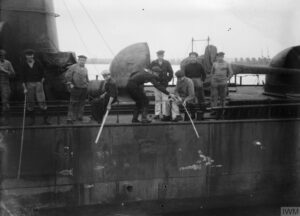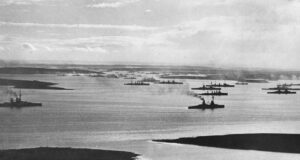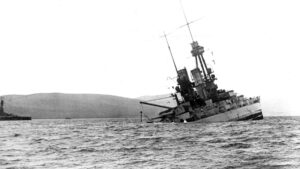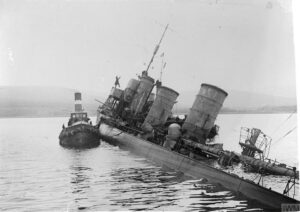
 After the November 11, 1918 German surrender in World War I, the German fleet was interned at Scapa Flow under the terms of the Armistice of 11 November, while negotiations took place over its fate. There was talk of the fleet being divided between the Allied nations, and there were those who really wanted that, but this brought the fear that the British would seize the ships, and the Germans worried that if the German government at the time might rejected the Treaty of Versailles and resumed the war effort, the newly confiscated German ships could be used against Germany. Amid all the speculation, Admiral Ludwig von Reuter decided to scuttle the fleet.
After the November 11, 1918 German surrender in World War I, the German fleet was interned at Scapa Flow under the terms of the Armistice of 11 November, while negotiations took place over its fate. There was talk of the fleet being divided between the Allied nations, and there were those who really wanted that, but this brought the fear that the British would seize the ships, and the Germans worried that if the German government at the time might rejected the Treaty of Versailles and resumed the war effort, the newly confiscated German ships could be used against Germany. Amid all the speculation, Admiral Ludwig von Reuter decided to scuttle the fleet.
Scapa Flow was a naval base in the Orkney Islands in Scotland. When the German ships arrived, they had full crews and in all, there were more than 20,000 German sailors aboard, the number of sailors was reduced in the ensuing months. When the full fleet was at Scapa Flow, there were 74 ships there during negotiations between the Allies and Germany over a peace treaty that would become Versailles. The discussion was about what to do with the ships, since they didn’t really want Germany to have a full fleet ready, should they decide to wage war again. The French and Italians wanted a portion of the fleet, but the British wanted them destroyed. They were concerned about their own naval superiority, should the ships be distributed among the other Allied nations.
The Germans didn’t want their ships in the hand of their enemies, so Admiral Ludwig von Reuter began to prepare for the scuttling in May 1919, after hearing about the potential terms of the Versailles Treaty. Shortly before the treaty was signed on June 21, Reuter sent the signal to his men. The men began opening flood valves, smashing water pipes, and opening sewage tanks. As the scuttle was taking place, nine German crew members who abandoned ship and attempted to come ashore were shot by British forces. As the ships were being scuttled, the intervening British guard ships were able to beach some of the ships. In all, 52 of the 74 ships were sunk. While he wouldn’t say so out loud, British Admiral Wemyss was delighted that the ships were 
 sunk, because that meant they wouldn’t be distributed to the French and Italians navies. Since the scuttling, many ships have been refloated and salvaged in the years since. Nevertheless, some remain in the seas at Scapa Flow. Those that remain are popular diving sites and a source of low-background steel.
sunk, because that meant they wouldn’t be distributed to the French and Italians navies. Since the scuttling, many ships have been refloated and salvaged in the years since. Nevertheless, some remain in the seas at Scapa Flow. Those that remain are popular diving sites and a source of low-background steel.


Leave a Reply